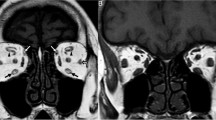Abstract
60 patients with Graves' ophthalmopathy were examined with CT before starting therapy. The muscle sizes were evaluated according to a staging, whereby more muscles were found to be enlarged in the group of patients with a short course of less than 2 years in comparison to the other group with a duration of disease of more than 2 years. These differences were particularly evident in the medialis and superior rectus muscle. However a long course of disease did not coincide with a reliable reduction in eye protusion. Additionally the density values differed according to the duration of disease, the lower ones being found in the group of patients with a long duration of disease. It can be assumed that fatty degenerations and/or fibrous alterations during the course of disease are responsible for this decrease in the density values.
Similar content being viewed by others
References
Cohen BA, PM Som, PH Haffner, AH Friedman: Steroid exophthalmus. J Comput Assist Tomogr 5 (1981) 907–908
Duke-Elder, St.: System of ophthalmology. Vol. XIII, Pat II. Kimpton, London 1974
Enzmann DR, SS Donaldson, JP Kriss: Appearance of Graves' disease on orbital computed tomography. J Comput Assist Tomogr 3 (1979) 815–819
Forbes G, CA Gorman, D Gehring, HL Baker: Computer analysis of orbital fat and muscle volumes in Graves ophthalmopathy. Amer J Neuroradiol 4 (1983) 737–740
Henkel D, P Stoeter: Computertomographische Dichtemessung dünner Stäbe am Orbitamodell. CT-Sonographie 2 (1982) 39–43
Langenbruch, K: Die Computertomographie der Orbita bei der endokrinen Ophthalmopathie. Fortschr Röntgenstr 135 (1981) 29–32
Markl A, T Hilbertz, CR Pickardt, B Mayr, J Lissner: Computertomographie bei endokriner Orbitopathie: Auswirkungen unterschiedlicher Gantry – Kippung und Patientenlagerung auf die Messung der Augenmuskeldicken und Möglichkeiten der Korrektur. Digit Bilddiagn 6 (1986) 81–85
Nugent RA, J Rootman, WD Robertson, JS Lapointe, PB Harrison: Acute orbital pseudotumors: classification and CT features. Amer J Roentgenol 137 (1981) 957–962
Uhlenbrock D, W Becker, W Appel, R Rohwerder: Die alte und neu aufgetretene endokrine Ophthalmopathie in der Computertomographie. Gemeinsamkeiten – Unterschiede. Fortschr Roentgenstr 139 (1983) 644–647
Uhlenbrock D, HJ Fischer: Computertomographie bei endokriner Ophthalmopathie mit malignem Exophthalmus. Dtsch Med Wschr 110 (1985) 495–499
Unsöld R, S Feldon, TH Newton: Zur Diagnose orbitaler Muskelerkrankungen. Klinische Anwendung von Computerrekonstruktionen. Klin Mbl Augenheilk 178 (1981) 436–438
Ullerich K, O Fischedick, D Uhlenbrock, R Rohwerder: Die Bedeutung der Computertomographie für die Diagnose und Therapiebeurteilung der endokrinen Orbitopathie. Akt Endokr Stoffw 4 (1984) 30–41
Author information
Authors and Affiliations
Rights and permissions
About this article
Cite this article
Uhlenbrock, D. Computed tomography in Graves' ophthalmopathy — evaluation regarding the muscle size and density units. Neurosurg. Rev. 11, 45–51 (1988). https://doi.org/10.1007/BF01795694
Received:
Accepted:
Issue Date:
DOI: https://doi.org/10.1007/BF01795694




